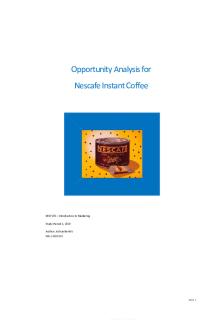Thermal Analysis Tutorial Final PDF

| Title | Thermal Analysis Tutorial Final |
|---|---|
| Course | Analytical Science 2 |
| Institution | University of Huddersfield |
| Pages | 2 |
| File Size | 130.7 KB |
| File Type | |
| Total Downloads | 39 |
| Total Views | 141 |
Summary
Dr Daniel Belton - Questions only...
Description
Thermal Analysis Tutorial 1. a) Describe the basic principle behind the operation of a thermogravimetric analysis (TGA) instrument. b) How can a TGA instrument be calibrated to ensure it is giving accurate temperature readings? c) Blue hydrated copper sulphate (CuSO4.5H2O) is a well known material which has been used to demonstrate many thermal techniques. Suggest a set of possible reactions to explain the experimental data in Figure 1. What does the DTG curve suggest about the reaction above 700ºC?
Figure 1. TG and DTG curves for copper sulphate pentahydrate, sample mass is 10.61 mg 2. a) (i) Describe the basic principle behind the operation of a differential scanning calorimetry (DSC) instrument. (ii) What are the two types of differential scanning calorimetry (DSC) instrument configuration? (iii) What is the main difference between a differential scanning calorimetry (DSC) instrument and a differential thermal analysis (DTA) instrument? (iv) What are the four ways in which a differential scanning calorimetry (DSC) instrument needs to be calibrated? b) Sketch a well-labelled phase diagram (temperature versus composition) for copper-aluminium alloy based on the information shown in Table 1 below and label the different regions of the diagram with the
applicable physical states. Table 1 Composition 100% copper, 0% aluminium 33% copper, 67% aluminium (eutectic point) 0% copper, 100% aluminium c) The thermogram from the DSC analysis of a polymer is shown in Figure 2. The three thermal events are labelled A, B and C. Assign the appropriate descriptions to each thermal event (A, B and C) from the following list: Glass transition
Endothermic
Exothermic
Melting
Crystallisation
Change in heat capacity
Melting Point /°C 1085 548 660
Heat flow
Exo A B
C
Temp Figure 2. DSC of polymer sample
d) A blend of polymers was submitted for analysis, and it was considered possible that the material contained a proportion of recycled polymer. A very widely recycled polymer is poly(ethylene terephthalate), PET, used for the majority of soft drink plastic bottles. The major impurity in the recycled product would be the caps made from polypropylene, PP. Many other bottles for household chemicals and shampoos are mainly high-density polythene, HDPE, and these too could contain PP as impurity. The DSC traces for two samples of “plastic” are given in Figure 3 together with typical thermal data for the constituents (Table 2). Calculate the enthalpy of each peak in mJ/mg (or J/g) of mixture. Calculate the percentage of PP and the other polymer in each sample. What event is likely to have occurred in sample 2 at around 80°C? (labelled X) Table 2 Polymer HDPE PP PET
Tg(°C) -120 -20 80
Tm(°C) 130 176 250
ΔHm(J/g) 180 100 40
X
Figure 3. DSC of polymer samples 1 and 2. Mass of sample 1 is 10.5 mg and sample 2 is 17.1 mg.
3. a) The oxalate hydrates of the alkaline earth metals; calcium, strontium and barium, are all insoluble and have been utilised in gravimetric analysis. Figure 4 below was obtained by heating calcium oxalate monohydrate on a thermal balance and shows three significant mass losses. Suggest a set of possible reactions to explain the experimental data.
Figure 4. TG and DTG curves for calcium oxalate monohydrate, sample mass is 8.9 mg b) An aqueous sample contains calcium, strontium and barium ions. The metal ions are precipitated as monohydrated oxalates. Describe how you would calculate the composition of the mixture utilising thermal gravimetric analysis. Explain how you would calculate the mass of barium in the sample if no step was present for the decomposition of barium carbonate to barium oxide....
Similar Free PDFs

Thermal Analysis Tutorial Final
- 2 Pages

Buckling Analysis Tutorial
- 63 Pages

Inua Ellams - tutorial analysis
- 1 Pages

Network analysis - Tutorial Work
- 9 Pages

SPSS Tutorial Cluster Analysis
- 42 Pages

BJT circuit analysis Tutorial
- 7 Pages

Opportunity Analysis final final
- 12 Pages

PBT150S Final tutorial 2019
- 3 Pages

MSproject Tutorial-Final Version
- 61 Pages

Final Assesment LAW436 TUTORIAL
- 5 Pages

Figtree tutorial - Apuntes Final
- 7 Pages

Final exam accsoc tutorial
- 2 Pages

Thermal Stress Doc
- 19 Pages

TOR Thermal Overload Relay
- 11 Pages
Popular Institutions
- Tinajero National High School - Annex
- Politeknik Caltex Riau
- Yokohama City University
- SGT University
- University of Al-Qadisiyah
- Divine Word College of Vigan
- Techniek College Rotterdam
- Universidade de Santiago
- Universiti Teknologi MARA Cawangan Johor Kampus Pasir Gudang
- Poltekkes Kemenkes Yogyakarta
- Baguio City National High School
- Colegio san marcos
- preparatoria uno
- Centro de Bachillerato Tecnológico Industrial y de Servicios No. 107
- Dalian Maritime University
- Quang Trung Secondary School
- Colegio Tecnológico en Informática
- Corporación Regional de Educación Superior
- Grupo CEDVA
- Dar Al Uloom University
- Centro de Estudios Preuniversitarios de la Universidad Nacional de Ingeniería
- 上智大学
- Aakash International School, Nuna Majara
- San Felipe Neri Catholic School
- Kang Chiao International School - New Taipei City
- Misamis Occidental National High School
- Institución Educativa Escuela Normal Juan Ladrilleros
- Kolehiyo ng Pantukan
- Batanes State College
- Instituto Continental
- Sekolah Menengah Kejuruan Kesehatan Kaltara (Tarakan)
- Colegio de La Inmaculada Concepcion - Cebu

